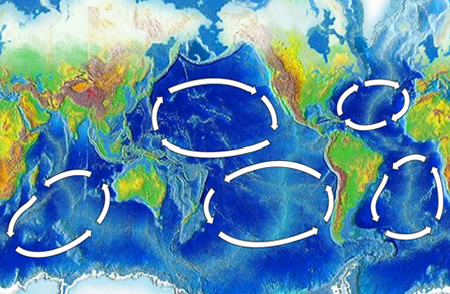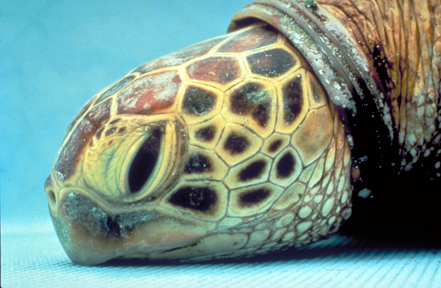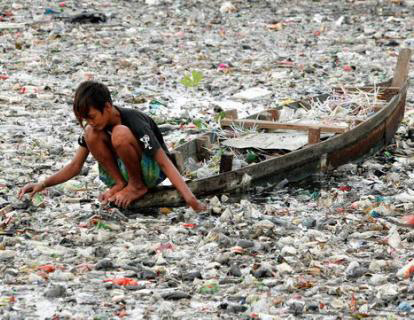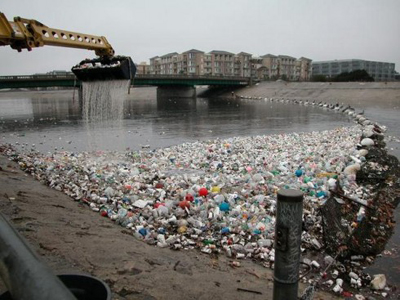|
Garbage disposal is a problem everywhere in our Insta-Life society. There are things we simply can’t throw away (the radioactive stuff), things we shouldn’t throw away (the toxic stuff), and lots of stuff we probably should never have made or purchased in the first place. No worries for us because we can just toss our trash away, out of sight and out of mind, while we go about the business of accruing more stuff we don't really need...right? Wrong. Sadly, we cannot mindlessly toss the trash out of reality, because trash doesn't magically disappear after it's been picked up by the collectors.
Our gigantic garbage pits are full to overflowing, mostly with leftover building materials, disposable diapers, and appliances. In the developed countries of the world, each human uses an average 200 pounds of plastic annually. While a tiny amount of the garbage is recycled into durable goods, about half the plastic we produce ends up in the landfills, and the rest of it becomes lost in the environment and ultimately washes out to the sea, to become trapped in a swelling, swirling limbo of heavily polluted ocean gyres, negatively affecting ocean health and, ultimately, every person and being on the entire earth.
A gyre in oceanography refers to large systems of rotating ocean currents, particularly those involved with large wind movements combined with vorticity of the water due, in part, to the spin of the Earth. The five most notable oceanic gyres are the North Atlantic, the South Atlantic, the North Pacific and the South Pacific, and the Indian Ocean.
|
Once the floating trash makes it to the gyres, it largely remains there permanently, caught in a circular flow that alternately grows and shrinks a bit depending on currents and wind conditions.
Contrary to popular belief, most of the trash in the oceans is not produced by ships dumping their waste into the sea, though that is also a huge problem that needs to be addressed. Research reveals that by far the biggest part of it was actually picked up by the wind from landfills, streets and roadsides, and then blown out to sea where the added weight of wetness holds it down. Once there, it starts to float wherever the currents take it, eventually winding up in one of these gyres.
About 90% of the garbage in the gyres is plastic because, simply put, plastic is made to last forever. Even as the so called "biodegradable" plastic breaks down, it reverts back into ‘nurdles’, the little miracle polymers that formed the plastic in the first place. The nurdles then get eaten by fish and cetaceans, killing many of them.
Trillions and more of these particles are floating in the world’s trash-filled gyres, looking like some sort of macabre party confetti.
|
So, the term "biodegradable plastic" is highly misleading because plastic never quite goes away, it just changes form. In the process, it continues to have the potential to leak chemicals into the environment and our food supply, and to cause untold damage in a multitude of ways.
DDT, PCBs, and other toxic chemicals that cannot dissolve in water are readily absorbed by the plastic. Fish that feed on plankton mistake the plastic for food and ingest the tiny plastic particles. Research has found the toxic chemicals absorbed by the plastic are then absorbed by the fish. Those that manage to survive the ingestion of the toxic stew are very likely to end up as food for bigger fish, many of which are caught for human consumption. This is how the toxins of plastics work their way up the food chain and into you. Turtles, fish, and birds all confuse floating plastic debris with food.
|
|
|
|
|
Of course, the trash doesn't always stay confined to the ever-growing pollution gyres out in the middle of the oceans, to destroy life outside of our view. Often oceanic storms will blow mountains of trash back onshore as well. Go to seashores world round and it is easy to see that as the tide comes in, it often brings various forms of human rubbish with it.
|
|
|
Get to the water’s edge near many big cities, and it’s thick enough you can actually walk on it. That trash can be seen easily, and while it is a travesty to our earth and its people that has been ignored far too long, the visible trash is at least easily avoided. Trash that is swirling about unseen in the oceans, however, cannot forever be avoided by any living soul on earth.
What to do about this issue? Is there anyway at all we can possibly hope to stem the rising tide of polluted tides? It's easy enough, and understandable, to get a hopeless feeling and be stunned into immobility. At the same time, doing nothing feels terribly wrong. We simply cannot continue to sit idly by to allow the wholly unnecessary and preventable destruction of our planet and its people, not only in the name of convenience but frankly, in the name of selfishness, ignorance, and laziness as well.
Thus, no matter how troubling the truth, education is the first key to positive change. A great place to start is with the 5 Gyres Project - Understanding Marine Pollution through Exploration, Education, and Action. The interactive interface takes one through five avenues of exploration in order to understand the problem, highlight the work of those who are working to rectify the situation, and to suggest ways in which we can become pro-actively involved in the effort.
To quote the great ideas from section, "What is the Solution?":
| Reduction Walk into any grocery or department store and try to fill a grocery cart with individual products that are not made from, packaged, or labeled with plastic. Though some products, like plastic bottles, have a recovery plan, most do not. Even fewer are truly recycled. Plastic lost at sea is an environmental and potential human health hazard. We must demand zero tolerance for plastic pollution. Reducing our consumption and production of plastic waste, and choosing cost-effective alternatives will go a long way towards protecting our seas - and ultimately ourselves. Action Inspire your company, community, school, and home to consider what they make and consume. Know the lifecycle of what you buy - what happens to your products when you're through with them? Shift some habits as you go along- commit to put your bags in the car, to not use plastic bottles, etc. Support legislative efforts to manage waste in your local community - your voice must be heard! Bring your own bag, bottle, cup, To-Go Ware, and inspire others to do the same. Be a leader in your industry and community for sustainable living. Knowing the impact of plastic pollution on the world, inaction is unacceptable. Legislation Knowing that plastic pollution is an environmental and potential human health hazard, and that current recovery and recycling efforts are inadequate, we must manage production and recovery of plastic responsibly through legislation. Bans and fees on disposable plastics are working to protect people and the environment worldwide. When businesses take responsibility (EPR) to recover products from consumers after use, they make more durable products, create less waste, and reduce the financial burden on municipalities and taxpayers paying to reduce waste. Innovation Necessity and we are in need of a huge change! Our capacity to come up with smarter approaches, ideas, and materials is limitless. Businesses must continue reinventing the way we make and consume our products, helping to forge a more sustainable world, and supporting communities that demand better alternatives. Responsible legislation creates opportunity for these alternatives. Steel water bottles and cloth grocery bags, biodegradable plastics and green chemistry, closed loop product lifecycles – these innovations and reinventions move us towards a more sustainable society, where the concept of "waste" has no place. Recovery Cleaning up plastic pollution from the world’s oceans is impractical. Our communities manage waste with landfills and recovery centers, screens on stormdrains and nets across rivers, but these post-consumer solutions are expensive to taxpayers. What works are economic incentives: return deposits on bottles, return deposits on products (EPR), and even a “Plastic Drive” for local schools to collect all types of plastic for $/pound. Efficient recovery of waste is essential - there is no "away" in throw-away. |
The Algalita Marine Research Foundation chronicles the problem of marine debris in our ecosystem. In their video entitled "Plastic Debris, Rivers to Sea", attention is brought to some of the ways people are proactively addressing the problem.
Capt. Charles Moore of the Algalita Marine Research Foundation first discovered the Great Pacific Garbage Patch. Now he's drawing attention to the growing, choking problem of plastic debris in our seas. Watch his talk given at TED, "The Seas of Plastic".
Project Kaisei is "a non-profit organization based in San Francisco and Hong Kong, established to increase the understanding and the scale of marine debris, its impact on our ocean environment, and how we can introduce solutions for both prevention and clean-up."
The report of Project Kaisei's research mission back in August, 2009 - "Project Kaisei confirms vast plastic debris island in Pacific".
Adam Sarvana, who writes about environmental and political issues for Natural Resources News Service, has a two-part series:
Fish and Paint Chips Part I: The Science of Trash
"Recent research has the National Oceanic and Atmospheric Administration (NOAA) concerned that the huge quantities of metal, plastic, paint chips and other man-made debris floating at sea, hundreds and even thousands of miles from land, may be working their way into the American diet..."
Fish and Paint chips part II: The Politics of Ocean Trash
"...The American Chemistry Council (ACC), the plastics industry trade association, repeatedly blocks efforts at stabilizing the use and consumption of plastics, arguing that whatever its environmental implications, plastic is good for the economy..."
Adam's articles features an interview with Holly Bramford, Director of NOAA’s Marine Debris Program.
Sometimes the problem lies simply in not knowing where to start. Luckily, research into the problem of the swirling oceanic pollution gyres will show there are serious efforts by some very dedicated groups of people to highlight and address this problem. We urge you to take the time to peruse these links and consider the information given within. We, the People created this problem, and only We, the People can fix it. But we have to get off our butts, get out of our of our comfort zones, and be willing to work together.
We think the Mission Statement of Ocean Conservancy sums it up rather well:
Providing food, fresh water and oxygen to the world, the ocean is essential to all life on Earth, but it is in serious trouble from overuse and pollution. Ocean Conservancy believes it’s time to change our national policies to protect entire ecosystems as the surest way to solve the most critical ocean conservation challenges we face. The ocean belongs to everyone and everyone is needed to protect it. To get there, we must collaborate across political lines and with new partners from all walks of life.
It’s not too late to fix things; a sea change can return the ocean to health.
Also see, "The Great Pacific Garbage Patch"










